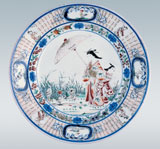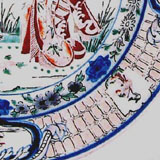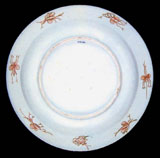- Museum Accession No.: EA1978.501
- Catalogue No.: 427
- Object type: Plate
- Kiln/Location: Imari
- Period/Date: 18th century (after 1737)
- Dimensions: H. 4.7 cm, D. 25.5 cm
- Provenance: Reitlinger gift
- Description: Plate. Underglaze blue and red, yellow, pink, green, aubergine and black with gold. In the centre, a geisha and her kamuro (apprentice), in red and gold kimonos under parasol. In front of the girls are three wading birds, including a ruff and a spoonbill, with tall grass in the background. In cavetto, a border in underglaze blue and enamels, of various floral sprays. On rim, four elaborate cartouches outlined in underglaze blue, containing birds and four subsidiary lobed panels containing geishas against a background of red octagons. On reverse, seven different insects in red around the rim.
This celebrated pattern, 'the Lady with the parasol', is taken from a drawing by the painter Cornelis Pronk (1691-1759), one of four commissioned by the VOC from 1734 over a period of three and a half years. This was the first of the designs, and the only one to be copied both in China and in Japan. Original drawings survive for this pattern, for a plate and a salt, in the Rijksmuseum, Amsterdam, Pronk was required to do five versions of each drawing, and to design all the shapes on which the designs might appear. The drawings for 'the Lady with the parasol' reached Japan in 1736, and the VOC attempted to order them in 1737 and again in 1744, without success; the price quoted by the potters was considered too high (see van der Velde and Bachofner, 1992, p. 468, and van der Velde, 1993, p. 90). As this design was used in Japan, it was clearly ordered by a private trader. The drawings must therefore have been sitting around in Deshima for five years, and the finished product must most likely have been ordered after 1744. It is the only 'Pronk' pattern that was used in Japan, and it is recorded only on plates; some enamelled, as here, others in blue-and-white only. Curiously, the blue-and-white version is the more rare. Many variations of this pattern were used in China on many different shapes, including on dinner services. Of the other Pronk designs used in China, 'the Doctors' and 'the Arbour' are the most often found. For a fully-illustrated discussion of the Pronk porcelains, see Jorg, 1980. Another example is illustrated by Jenyns, 1965, pl. 46A, and its Chinese counterpart as pl. 46B.
- Exhibited:
- Similar Example:
- Illustrated:
|
Main View
|





